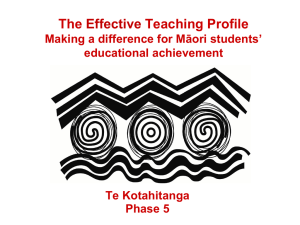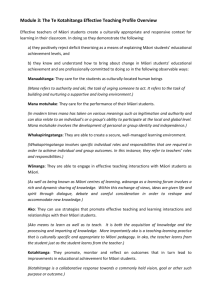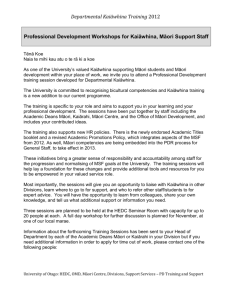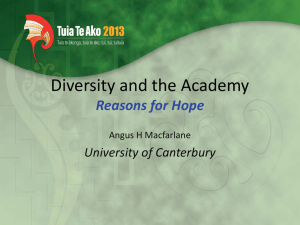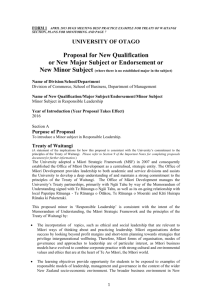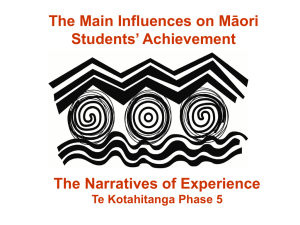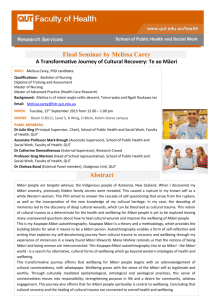Identification of gifted Māori students (Word
advertisement
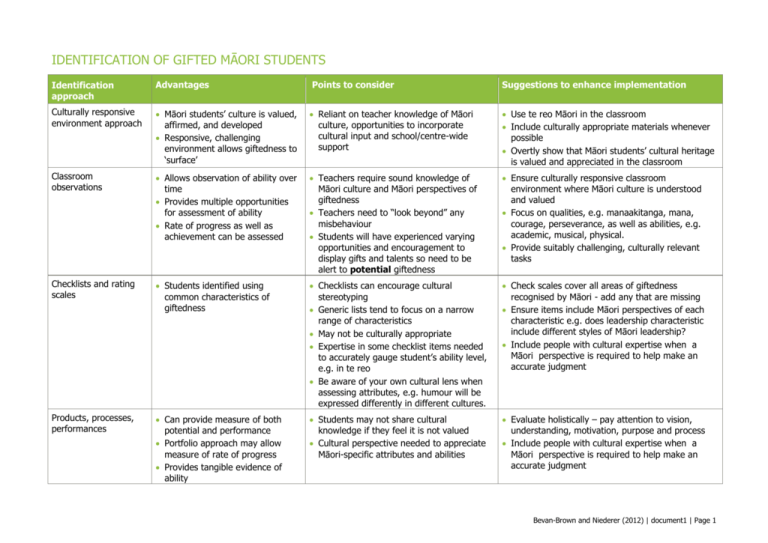
IDENTIFICATION OF GIFTED MĀORI STUDENTS Identification approach Advantages Points to consider Suggestions to enhance implementation Culturally responsive environment approach Māori students’ culture is valued, affirmed, and developed Responsive, challenging environment allows giftedness to ‘surface’ Reliant on teacher knowledge of Māori culture, opportunities to incorporate cultural input and school/centre-wide support Use te reo Māori in the classroom Include culturally appropriate materials whenever possible Overtly show that Māori students’ cultural heritage is valued and appreciated in the classroom Classroom observations Allows observation of ability over time Provides multiple opportunities for assessment of ability Rate of progress as well as achievement can be assessed Teachers require sound knowledge of Māori culture and Māori perspectives of giftedness Teachers need to “look beyond” any misbehaviour Students will have experienced varying opportunities and encouragement to display gifts and talents so need to be alert to potential giftedness Ensure culturally responsive classroom environment where Māori culture is understood and valued Focus on qualities, e.g. manaakitanga, mana, courage, perseverance, as well as abilities, e.g. academic, musical, physical. Provide suitably challenging, culturally relevant tasks Checklists and rating scales Students identified using common characteristics of giftedness Checklists can encourage cultural stereotyping Generic lists tend to focus on a narrow range of characteristics May not be culturally appropriate Expertise in some checklist items needed to accurately gauge student’s ability level, e.g. in te reo Be aware of your own cultural lens when assessing attributes, e.g. humour will be expressed differently in different cultures. Check scales cover all areas of giftedness recognised by Māori - add any that are missing Ensure items include Māori perspectives of each characteristic e.g. does leadership characteristic include different styles of Māori leadership? Include people with cultural expertise when a Māori perspective is required to help make an accurate judgment Products, processes, performances Can provide measure of both potential and performance Portfolio approach may allow measure of rate of progress Provides tangible evidence of ability Students may not share cultural knowledge if they feel it is not valued Cultural perspective needed to appreciate Māori-specific attributes and abilities Evaluate holistically – pay attention to vision, understanding, motivation, purpose and process Include people with cultural expertise when a Māori perspective is required to help make an accurate judgment Bevan-Brown and Niederer (2012) | document1 | Page 1 Identification approach Advantages Points to consider Suggestions to enhance implementation Teacher nomination Utilises teachers’ knowledge of student Potential for low &/or inaccurate identification because many teachers are white, middle class, monocultural with limited knowledge of Māori culture and Māori concepts of giftedness Many teachers have low expectations of Māori students. Have high expectations for students and understand and appreciate Māori culture. Improved by use of specifically developed lists of culturally appropriate characteristics and behaviours and consultation with cultural experts if/when needed Parent nomination Utilises parents’ in depth knowledge of their child. Parents may see nomination as whakahihi (boasting) so not suggest their child. Poor/minimal relationship with teacher will negatively affect parents’ responses. Ask parents about their child’s strengths, interests and out-of-school involvements. Establish positive relationship with parents before asking for nominations Whanau and Māori community/group nomination Whanau will have valuable information about children’s strengths, talents and precocious development. Community members may identify child’s cultural abilities and qualities. Particularly helpful where teachers have limited cultural and reo knowledge. Effectiveness dependent on positive existing relationship between whanau or community and teacher. Best sought within context of culturally appropriate and welcoming activities, such as a school powhiri or kapa haka concert. Peer nomination Māori students recognise their peers’ strengths and talents and are willing to share this information to trusted teachers. Particularly useful for gifts exhibited outside the school environment Effectiveness dependent on a culturally responsive environment where there is a trusting relationship between students and teacher Use range of ways to collect information, including formal/informal, written/oral. Take note of who students go to for assistance and support, and who appears to have mana amongst their peers – they may be gifted Bevan-Brown and Niederer (2012) | document1 | Page 2 Identification approach Advantages Points to consider Suggestions to enhance implementation Self nomination Provides opportunities for students to share their strengths, some of which may not be evident within the normal school environment. Students may feel as if they are being boastful, and so not want to nominate themselves. Effectiveness dependent on trusting pupil-teacher relationship Effective if handled sensitively in culturally responsive, nurturing environment. Students are more likely to share their interests and aspirations with someone who is genuinely interested in them and the outcome of this nomination is known and acceptable to them Tests Culturally appropriate, relevant written tests give students an opportunity to exhibit their cultural expertise Non-verbal tests have potential as they are not reliant on language and their content is less prone to cultural bias Potential for cultural bias of test norms and content in standardised tests. Recognise high scores but interpret average or low scores with caution Pen and paper tests may disadvantage children uncomfortable or unfamiliar with this format. In these circumstances oral tests may be more useful Teacher made tests that incorporate cultural perspectives and include open ended and divergent thinking items may be more effective than standardised tests Practical strategies and ideas that complement this checklist can be found in this article on which it is based and other Māori-relevant readings on this website. Bevan-Brown and Niederer (2012) | document1 | Page 3

